#glossary SEOterms digitalmediamarketing
Explore tagged Tumblr posts
Text
Glossary: Beginners Guide to Internet Marketing
BEGINNERS GUIDE TO SEO:
GLOSSARY
SEARCH ENGINE OPTIMIZATION (SEO) & OTHER COMMON DIGITAL MEDIA MARKETING TERMINOLOGY, ACRONYMS, PHRASES & JARGON
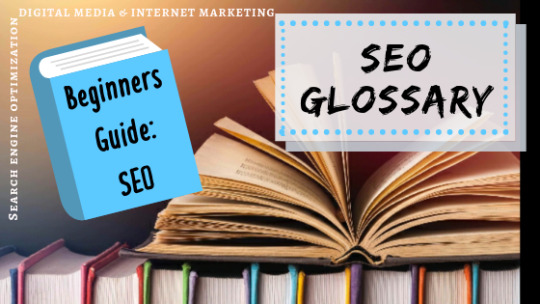
Whether you are conducting research, indulging your curiosity or looking for services regarding SEO, you will come across terminology you may be unfamiliar with. Understanding it may prove difficult as many of these terms or phrases are not typically used in the average person's daily life. At,InSite Digital Solutions, we want you to have a better understanding of what Search Engine Optimization is, in order to share a mutual understanding of what we do and why it’s important for your business. We've compiled a list of the most common SEO & Internet Marketing terms along with easy to understand definitions, helping to answer the WHAT’s, WHY’s and the HOW.
NOTE: If you see a term that you feel needs more clarification or don't see a word or phrase you were looking for, please comment below so that it can be added to our glossary as this will continue to be updated regularly.
Constructive criticism always welcome!
*SEO TERMS, PHRASES & JARGON*
A - Z
ALGORITHM (pertaining to Google):
The formula that Google uses in order to accurately rank the top results relating to your search query. Also, it's algorithm helps to locate and remove harmful websites containing things that do not follow their guidelines such as viruses, spam or malware, protecting their online users
ANCHOR TEXT:
Typically in blue and underlined, anchor text is the clickable word or words used to make a link instead of the domain or URL. It is a good SEO practice to make sure this text relates to the page that it links to. An example would be if you saw a link for InSite Digital Solutions that looked like this: “Check out our Home page for more information!" in which the link to the site is there, however, the anchor text is in place of the website's URL
AUDIT:
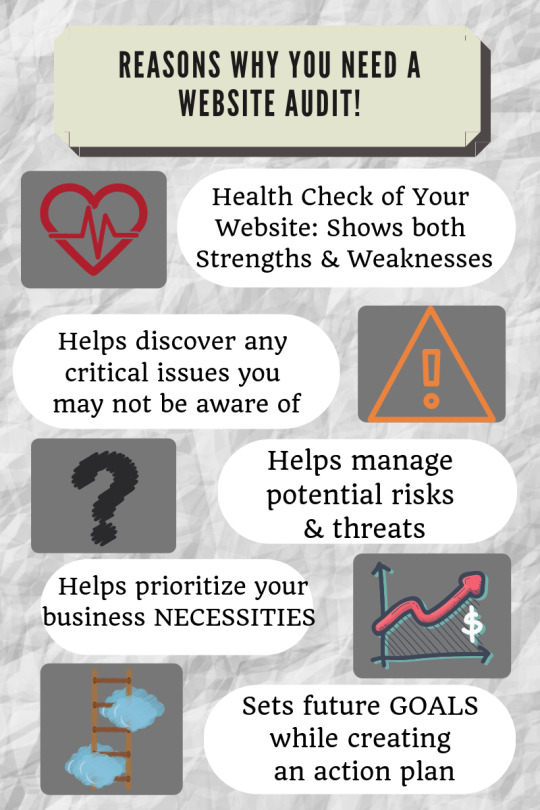
Think of an audit as your yearly health check-up. However, instead of you, your website is being analyzed in order to identify any/all strengths and weaknesses. For example, you may receive results about critical issues, threats, risks, opportunities, and feedback, and the strengths and weaknesses overall. It will tell you how much traffic your site is currently pulling in, or if you need keyword optimization, or image optimization plus much more. Once you have gotten your site audit results, your SEO consultant will be able to to help create your marketing plan in order to maximize your site's potential
BACKLINK:
A backlink, also known as an “inbound link” is when a web page provides a link to another site which then “links” the two sites together. An example would be in the resource section on many sites that use outside links which take you to a separate website instead of linking within their own domain. There are two kinds: Internal & External, both defined in this glossary
BLACK HAT SEO:
This type of SEO refers to the use of unethical strategies and practices that go against Google’s rules and regulations. Be wary of those looking to make a quick buck taking the cheapest route & faster than normal results. If a website, or person in charge of it, is caught wrongfully acquiring backlinks through the use of black hat SEO tactics, it can result in complete banishment from the search engines altogether. The phrase "you get what you pay for" is applicable in SEO
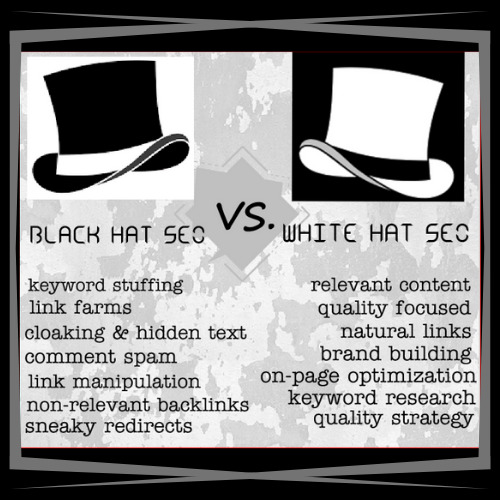
**NOTE: On average, it can take a month or two for optimal SEO results to take full effect, however, when done correctly it generates a very good ROI**
BROKEN LINK:
Also referred to as a “dead link”, a broken link is a link or webpage that no longer works and cannot be accessed by an online user, due to a variety of reasons why. We’ve all seen those error pages that say "Error: 404 PAGE NOT FOUND blah blah blah", right? AKA broken link example.
REASONS YOU MAY HAVE A BROKEN LINK:
Any spelling errors in the link itself
Incorrect URL posted by website's owner
Firewall keeping outside visitors out
Link removed from the destination page (aka landing page)
BROWSER:
A browser is computer software used in order to acquire information on the World Wide Web. Examples of browsers: Google Chrome, Mozilla Firefox, or Microsoft Edge. When you make a request in your browser, you’re instructing your browser to retrieve the resources and information necessary in order to present that page on your media device
CANONICAL TAGS:
A canonical tag is a partial fragment of HTML coding that specifies the primary version, or the original main context page, for deciphering a duplicate, near-duplicate, or similar page. Google, Yahoo, and Microsoft all came together and created them to give website owners an option to quickly solve any duplicate content issues
CLOAKING:
Cloaking is a great example of a black hat SEO tactic. Cloaking is a technique used to obtain a higher search engine rank for certain keywords or phrases. Once the website is created, specific keywords are added to the pages in a way that delivers different results to a search engine's spider bots, (see CRAWLER definition) online users who visit that website are seeing completely different and unrelated content
CONTENT:
In SEO terms, you'll see the word “content” tossed around quite a bit. Content refers to as any and all information that lives on the web and can be read, seen, viewed or absorbed on the web. One of the main parts of SEO is to generate new and updated content on a consistent basis to obtain a higher Pagerank on the search engine results. As a user, it’s what I like to call the noun of the internet- the person, place or thing that you are searching for.. the main substance of the user's interest
CPC: (COST PER CLICK)
The actual dollar amount of money that you are charged when an online user clicks on your paid advertisements
CRAWLER:(SPIDER, WEB SCRAPING, SPIDERBOT)
A program or Internet bot used by search engines to analyze content, “crawl” through internal and external links, and scan the website's data from beginning to end. It’s purpose being to generate entries for a search engine index and provide efficient, relevant searches for the users to browse through
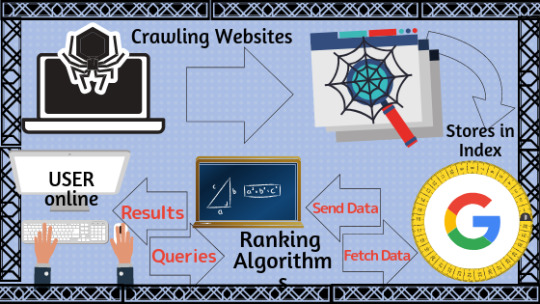
DE-INDEXING:
De-indexing happens when a website, webpage, or some sort of content is taken down or removed from its index completely (i.e. Google’s database). Once removed AKA de-indexed by a search engine, it does not show up in the search engine results for any search phrases or even with the specified URL
Some things that cause de-indexing involve many black hat SEO tactics such as hidden links, spam, phishing, malware, viruses, cloaking, etc. that strictly goes against Google's rules and regulations
DO-FOLLOW:
A do-follow link is when another website/domain (business, blog, organization, etc.) places a link to your website on one of their web pages. Do-follow links allow crawler bots to crawl through to reach your site in order to pass along Pagerank. These links get credit and value from the search engine as it provides both sites with link juice plus a (relevant and/or quality, let's hope) backlink or external link. If a webmaster is linking back to you with this link both Search Engines and Humans will be able to follow
DOMAIN AUTHORITY (DA): Developed by Moz and also known as Domain Rating (DR)
D.A. is a measurement or “score” of a website’s valuable & relevant links while also showing how likely it is to rank on the SERP (Search Engine Result Page). It is calculated by many factors, however, the quality and quantity of links seem to be at the forefront. The domain authority ranking is on a 0 to 100 scale, and this metric provides a more accurate estimation of the website's ability to get organic search traffic from Google. A higher score renders a higher value and can help you rank higher if linking to or from their site
DEEP LINKING:
Deep linking is the use of a specific hyperlink that links to a certain piece of web content on a website, rather than the website's home page or main page
EXTERNAL LINK:
External Links are hyperlinks that point at any domain other than the current one that the link exists on. For instance, another website that links to your site would be an external link for them or if you link another domain on your site, then that is considered an external link for you
HYPERLINK:
A hyperlink is a clickable link that takes you from your current domain to another domain via references called anchor texts (above in glossary).
INDEXING:
This is the process of adding web pages into Google’s giant search engine database. This is where web crawling comes into play, once the search engine has deployed it's crawler bots that have crawled through the site, it will be able to index it into the database. Think of the website as a book and the database as a library. In order to show up in the search results (library), you have to have your page crawled for content and relevancy before it can become indexed (checked into) into the library
INTERNAL LINK:
Internal links are links used mainly for navigation purposes, linking from one page of a website to another page on the same site. For instance, you may get the home page and any link on there, within the menu or throughout the content, Not only are they used to help users locate similar content and articles but also help in increasing page views and internal page rank, reducing bounce rate, and improving indexing and crawled pages.
KEYWORDS:
In the context of SEO, a keyword is a particular word or phrase that describes the contents of a web page and form part of a web page's metadata. Keywords help search engines match a website or one of its pages with a relevant search query. In other words, they are used when performing a search to help users to describe what type of content they are seeking to find
LANDING PAGE:
Also known as a "lead capture page", this is the page that a visitor “lands” when they have clicked on a Google AdWords ad or result on their result page. In essence, the page that comes up once you've clicked on its link
LSI KEYWORDS:
LSI stands for Latent Semantic Indexing. This is an equation/formula that search engines use to provide accurate search results by predicting patterns in which similar words and phrases are used to better understand the context. For instance, if you put the word “computer” into your search, you may see laptops appear on your result pages. It also helps to understand the difference between an apple you eat and Apple the brand based upon the other words used in the search. (i.e- when searching “apple” online, LSI determines whether to provide information on either the fruit or on the brand based upon other words used in your search such as “calories” and "nutrition" OR “computers” and "iOS")
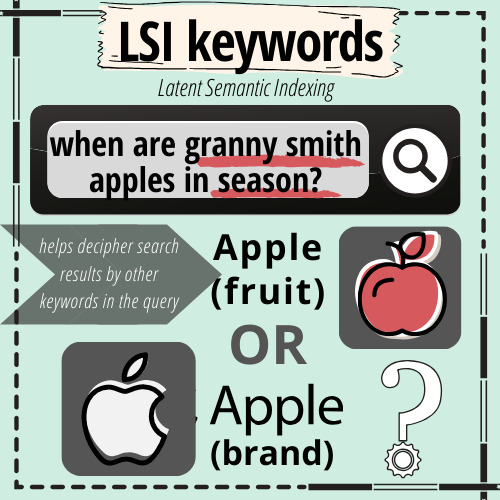
LINK BUILDING:
Link Building is the process of getting other websites to link back (placing a link on their website that goes right to your website, or one of its pages) to your website, and vice versa. In some cases, you can exchange links. The higher the quality of the links you have, the better your quality and trust become, and the higher your Domain Authority score will become. It has been said that this is one of the most important parts of SEO but it’s also one of the hardest parts according to many SEO's and other marketing consultants.. and as I carried a "Back Linker" job title previously, I can completely agree with that statement!
LINK FARM:
A link farm is a questionable tactic in SEO where a website is created with the sole purpose being to get backlinks for your website or exchanging reciprocal links to try and increase search engine optimization. In laymen's terms, people create websites just to add links to it, meaning a bunch of random links for all sorts of random types of companies/sites/content, that are not directly related to a certain topic. Again, people use this as a way to obtain backlinks for their website where the quantity of links is the objective. This can hurt your SEO and Pagerank because it would not be considered a quality link or contain relevancy to the content of a website
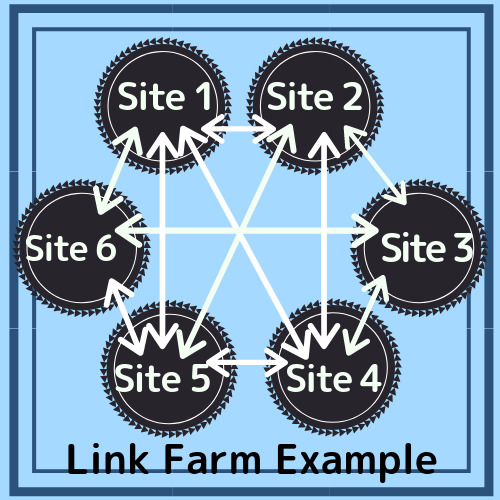
METADATA:
Metadata is basically data that describes other data. It provides content-related information about a certain piece of data. For example, when you take a picture, some information like the date, time, location and other info is already saved once it’s taken. For example, a Microsoft Word text document has metadata that contains information about how long the document is, the name of the author, what date the document was written, and a short summary describing the content of the document. Metadata is often in the form of meta tags (See below)
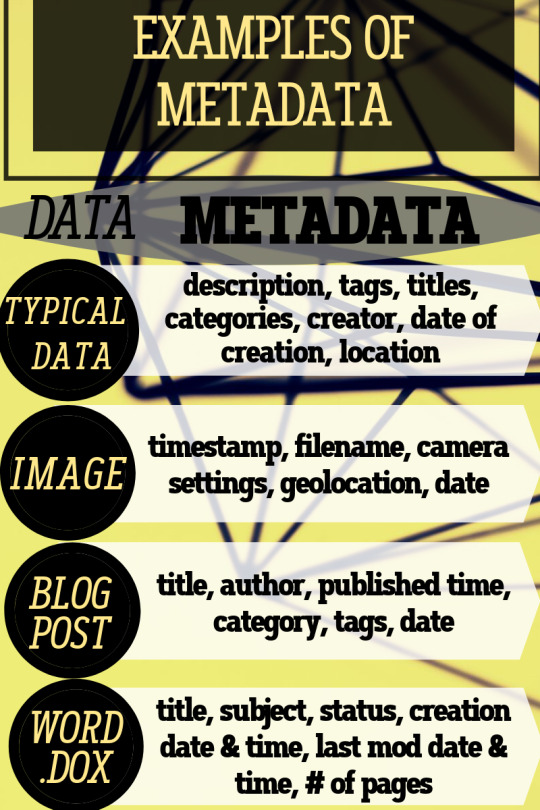
META TAGS:
Meta tags are pieces of HTML source code that don't appear on the actual page, but it is in the coding to help describe the content on your site to the search engines
NATURAL LINKS:
A natural link is a link that you have obtained outside of your link building strategy, no contact was made to that site to obtain the backlink. You can acquire natural links by having high-quality content and valuable information, amongst many other things, that another website deems beneficial and relevant to their business/cause/website enough to add your link on their website/page
NO FOLLOW:
A no-follow link is typically an external link that a website does not want to pass authority ("support" or "endorse") to, then by using a snippet of HTML relation code, (rel="nofollow") Google does not transfer PageRank across these links. You don't receive credit for these links and the site crawlers cannot crawl through them. This doesn’t help in terms of it showing up in the search engine or giving credit to a site as a backlink, but there is still value within a nofollow link
OFF-PAGE SEO:
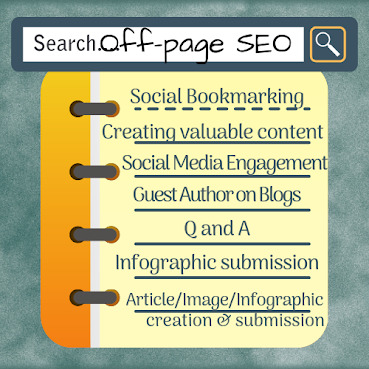
Also called off-site SEO that pertains to any efforts or strategies used outside of a website to improve its search rank. An example of this would be going to local businesses and speaking with them personally to try and get your link on their site as local SEO
ON-PAGE SEO:
AKA Off-page SEO. This is referring to all measures taken directly within the website itself, in order to improve SEO, such as creating new and fresh content for your target audience, increasing page loading speeds, keyword optimization and other examples in the infographic to the left
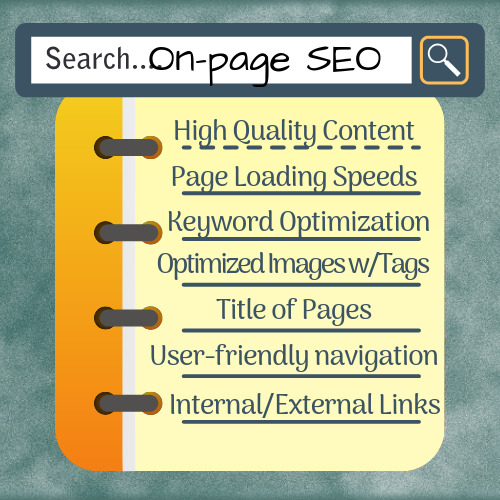
ORGANIC TRAFFIC:
Organic traffic refers to all visits to your website directly from search engine search results and not by a paid ad or other means
PAGERANK:
PageRank is a search engine algorithm, invented by Google founders Larry Page and Sergey Brin, that provide a ranking/measurement system for websites to determine the site’s authority and trust as well as its quality and quantity of links on a scale of 0 to 10. By ranking the pages, it provides the user with more accurate results on the results page
PPC:
Stands for Pay-Per-Click and is a form of paid advertisement where advertisers pay ad agencies whenever a potential prospect clicks on their online ad.
QUERY:
In the English language, it means a question or an inquiry. In SEO, it is similar in that it is a request for information, answers, or data from the search engine's database. In laymen's terms, your query is what you type into the search engine bar
ROI:
(Return on Investment) Pretty self-explanatory, but lets throw in some other info. For starters, ROI consists of what you have already invested in a marketing agency and the profitability of that investment. This is why you cannot guarantee SEO (Find out more about ROI and SEO here) If you are doing a Pay Per Click Campaign then the ROI is an easier calculation, if you end up with more money than spent, then you clearly have a positive ROI. It is more difficult to calculate with SEO as SEO ROI involves targeting traffic organically on the result pages (organically, meaning through the community, word of mouth, purchases, subscriptions, other sign-ups etc)
SEO:
SEO- our topic of the hour.. Search Engine Optimization is what it is known as. The best way to explain it is that we are, in a sense, trying to beat the algorithm for Google and other search engines so that the website (client site or your site) is on the right side of the equal sign (literally and figuratively). SEO is accomplished by executing multiple methods like doing continuous updates, keep on researching, staying updated with the algorithm changes, and using resources.... with the main goal of SEO being to help the website obtain a higher PageRank. Or, closest to the top of your search engine result page (SERP), as almost every online user chooses results on the first page. When is the last time you went out to the 16th result page?
SEM:
Search Engine Marketing- similar to SEO as it is used as an umbrella term. However, SEM utilizes PPC techniques and pays for links and advertisements.
**Most people ( do not click on the advertisements and go immediately to the organic results instead, which is what SEO services provide
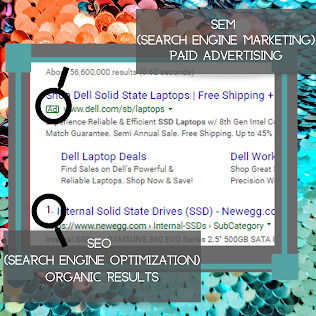
SERP:
Search Engine Result Page. A SERP is a page of results that come up after you’ve entered your query into the search engine. Basically, exactly what it stands for
SMM:
Social Media Marketing- a form of internet marketing that uses social media platforms and networking websites as a marketing tool to promote a brand or a particular company
SUBDOMAIN:
a subdomain is just an extension of the main domain, in other words, it is a smaller part of a larger domain in the DNS (Domain Name System) hierarchy. For example: if you visit the URL ilovelamp.com, an example of a subdomain would be something like shop.ilovelamp.com, blog.ilovelamp.com, or faq.ilovelamp.com)
TARGET AUDIENCE:
Your target audience consists of everyone who is searching online for products you make or carry, services you provide, the information you've written on your page, etc. SEO aims to reach your target audience and bring these users to your site to generate traffic
URL:
Uniform Resource Locator- an identifier or specified address to locate a resource or specific piece of content on the internet

WHITE HAT SEO:
Just the opposite of Black Hat SEO, white hat SEO refers to compliant and approved tactics that are used to improve a website's SEO. No rules are broken to gain higher ranks on SERPs and only quality links with honest tactics that fall under Google’s guidelines
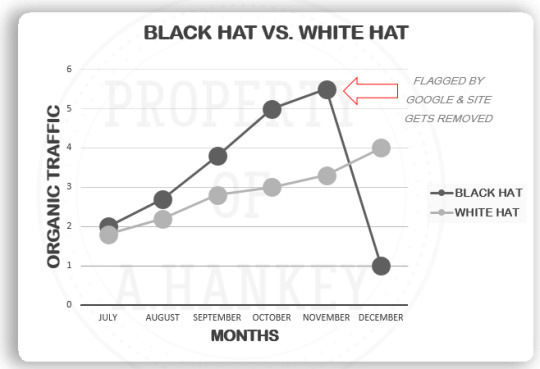
1 note
·
View note